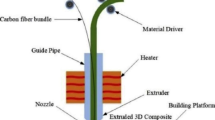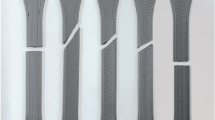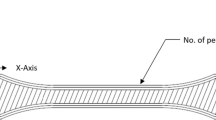Abstract
The technology of additive manufacturing has advantages for prototy**. In certain instances, it may be preferable to use 3D-printed components as the primary component making it essential for these components to have sufficient mechanical properties. Therefore, the effect of ambient conditions on the mechanical properties of these components can be quite significant. In this study, the effect of different ambient conditions on the mechanical properties of 3D-printed PLA parts was investigated. Three specific conditions were considered for this purpose: hot-dry air, hot water, and cold-dry air. Standard samples were fabricated using a 3D-printer and then subjected to the aforementioned environments for 30-min before being tested with a universal testing device. The yield strength, maximum strength, elastic modulus, and toughness values were obtained from the resulting stress–strain graphs of the printed components. The study revealed that ambient conditions significantly affect the mechanical strength of PLA components. Notably, the components retained their tensile strength in cold and dry environments, whereas their mechanical properties deteriorated under wet conditions. Additionally, cold conditions appeared to enhance the mechanical properties of the printed components. In conclusion, it was determined that variable ambient conditions can either degrade or improve the mechanical properties of PLA-printed components.





Similar content being viewed by others
References
B.I. Oladapo, S.A. Zahedi, and A.O.M. Adeoy, 3D Printing of Bone Scaffolds with Hybrid Biomaterials, Compos. Part B Eng., 2019, 158(1), p 428–436. https://doi.org/10.1016/j.compositesb.2018.09.065
H. Rastin, B. Zhang, J. Bi, K. Hassan, T. Tung, and D. Losic, 3D Printing of Cell-Laden Electroconductive Bioinks for Tissue Engineering Applications, J. Mater. Chem. B, 2020, 8(27), p 5862–5876. https://doi.org/10.1039/D0TB00627K
M. Korger, A. Glogowsky, and M. Rabe, Testing Thermoplastic Elastomers Selected as Flexible Three-Dimensional Printing Materials for Functional Garment and Technical Textile Applications, J. Eng. Fibers Fabr., 2020, 15, p 1–10. https://doi.org/10.1177/1558925020924599
T. Kozior, A. Mamun, M. Trabelsi, L. Sabantina, and A. Ehrmann, Quality of the Surface Texture and Mechanical Properties of FDM Printed Samples after Thermal and Chemical Treatment, Stroj. Vestn. J. Mech. Eng., 2020, 66(2), p 105–113. https://doi.org/10.5545/sv-jme.2019.6322
T. Blachowicz and A. Ehrmann, 3D Printed MEMS Technology-Recent Developments and Applications, Micromachines, 2020, 11(4), p 434. https://doi.org/10.3390/mi11040434
D. Ahrendt and K.A. Romero, Development of a Computer-Aided Engineering–Supported Process for the Manufacturing of Customized Orthopaedic Devices by Three-Dimensional Printing onto Textile Surfaces, J. Eng. Fibers and Fabr., 2020, 15(1), p 1558925020917627. https://doi.org/10.1177/1558925020917627
R.O. Moreno, D. Carou, D.A. Carazo, and M.K. Gupta, Statistical Models for the Mechanical Properties of 3D Printed External Medical Aids, Rapid Prototyp. J., 2020, 27(1), p 176–186. https://doi.org/10.1108/RPJ-02-2020-0033
I. Vroman and L. Tighzert, Biodegradable Polymers, Materials, 2009, 2(2), p 307–344. https://doi.org/10.3390/ma2020307
R.A. Wach, P. Wolszczak, and A. Adamus-Wlodarczyk, Enhancement of Mechanical Properties of FDM-PLA Parts via Thermal Annealing, Mater. Eng., 2018, 303, p 1800169. https://doi.org/10.1002/mame.201800169
V. Verney, N. Schiavone, and H. Askanian, Effect of 3D Printing Temperature Profile on Polymer Materials Behavior, 3D Print. Addit. Manuf., 2020, 7(6), p 311–325. https://doi.org/10.1089/3dp.2020.0175
N. Jayanth, K. Jaswanthraj, S. Sandeep, M.N. Harish, and S.S. Raghul, Effect of Heat Treatment on Mechanical Properties of 3D Printed PLA, J. Mech. Behav. Biomed. Mater., 2021, 123(1), p 73–78. https://doi.org/10.1515/mt-2020-0010
M.P. Kumar, S. Ponnusamy, and N.M.S. Reddy, The Influence of Process Parameters on the Impact Resistance of 3D Printed PLA Specimens under Water-Absorption and Heat-Treated Conditions, Rapid Prototyp. J., 2021, 27(6), p 1108–1123. https://doi.org/10.1108/RPJ-02-2020-0037
A. Lanzotti, M. Grasso, G. Staiano, and M. Martorelli, The Impact of Process Parameters on Mechanical Properties of Parts Fabricated in PLA with an Open-Source 3-D Printer, Rapid Prototyp. J., 2015, 21(5), p 604–617. https://doi.org/10.1108/RPJ-09-2014-0135
S. Farah, D.G. Anderson, and R. Langer, Physical and Mechanical Properties of PLA, and Their Functions in Widespread Applications—A Comprehensive Review, Adv. Drug Deliv. Rev., 2016, 107, p 367–392. https://doi.org/10.1016/j.addr.2016.06.012
T. Kozior, T. Blachowicz, and A. Ehrmann, Adhesion of Three-Dimensional Printing on Textile Fabrics: Inspiration from and for Other Research Areas, J. Eng. Fibers Fabr., 2020, 15, p 1–6. https://doi.org/10.1177/1558925020910875
A.A. Bakır, R. Atik, and S. Özerinç, Mechanical Properties of Thermoplastic Parts Produced by Fused Deposition Modeling: A Review, Rapid Prototyp. J., 2021, 27(3), p 537–561. https://doi.org/10.1108/RPJ-03-2020-0061
V. DeStefano, S. Khan, and A. Tabada, Applications of PLA in Modern Medicine, Eng. Regen., 2020, 1(1), p 76–87. https://doi.org/10.1016/j.engreg.2020.08.002
A. Chalgham, A. Ehrmann, and I. Wickenkamp, Mechanical Properties of FDM Printed PLA Parts Before and After Thermal Treatment, Polymers, 2021, 13(8), p 1239. https://doi.org/10.3390/polym13081239
N.D. Moreno, M.A. Garcia, M.A.P. Vicente, and L.R. Parada, Product Design by Additive Manufacturing for Water Environments: Study of Degradation and Absorption Behavior of PLA and PETG, Polymers, 2021, 13(7), p 1036. https://doi.org/10.3390/polym13071036
Y. Tokiwa and B.P. Calabia, Biodegradability and Biodegradation of Poly(lactide), Appl. Microbiol. Biotechnol., 2006, 72(2), p 244–251
D.I. Vos and M.H.J. Verhofstad, Indications for Implant Removal After Fracture Healing: A Review of the Literature, Eur. J. Trauma Emerg. Surg., 2013, 39(4), p 327–337. https://doi.org/10.1007/s00068-013-0283-5
S. Wickramasinghe, T. Do, and P. Tran, FDM-Based 3D Printing of Polymer and Associated Composite: A Review on Mechanical Properties, Defects and Treatments, Polymers, 2020, 12(7), p 1529. https://doi.org/10.3390/polym12071529
M. Behzadnasab, A.A. Yusefi, D. Ebrahimibagha, and F. Nasiri, Effects of Processing Conditions on Mechanical Properties of PLA Printed Parts, Rapid Prototyp. J., 2020, 26(2), p 381–389. https://doi.org/10.1108/RPJ-02-2019-0048
V.K. Tiwary and V.R. Malik, An Overview on Joining/Welding as Post-processing Technique to Circumvent the Build Volume Limitation of an FDM-3D Printer, Rapid Prototyp. J., 2021, 27(4), p 808–821. https://doi.org/10.1108/RPJ-10-2020-0265
Funding
This research received no specific grant from any funding agency
Author information
Authors and Affiliations
Corresponding author
Additional information
Publisher's Note
Springer Nature remains neutral with regard to jurisdictional claims in published maps and institutional affiliations.
Rights and permissions
Springer Nature or its licensor (e.g. a society or other partner) holds exclusive rights to this article under a publishing agreement with the author(s) or other rightsholder(s); author self-archiving of the accepted manuscript version of this article is solely governed by the terms of such publishing agreement and applicable law.
About this article
Cite this article
Çelik, T., Dizdar, A. Effects of Different Ambient Conditions on Mechanical Properties of 3D Printing Parts Produced with Fused Deposition Modeling. J. of Materi Eng and Perform (2023). https://doi.org/10.1007/s11665-023-08709-4
Received:
Revised:
Accepted:
Published:
DOI: https://doi.org/10.1007/s11665-023-08709-4




